
A gurdwara or gurudwara is a place of assembly and worship for Sikhs but its normal meaning is place of guru or "Home of guru". Sikhs also refer to gurdwaras as Gurdwara Sahib. People from all faiths and religions are welcomed in gurdwaras. Each gurdwara has a Darbar Sahib where the Guru Granth Sahib is placed on a takht in a prominent central position. Any congregant may recite, sing, and explain the verses from the Guru Granth Sahib, in the presence of the rest of the congregation.

Guru Hargobind was the sixth of ten Gurus of the Sikh religion. He had become Guru at the young age of eleven, after the execution of his father, Guru Arjan, by the Mughal emperor Jahangir.
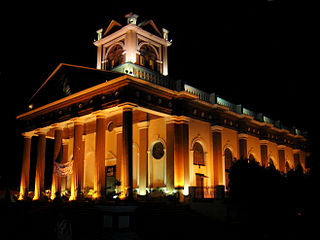
Kapurthala is a city in Punjab state of India. It is the administrative headquarters of Kapurthala District. It was the capital of the Kapurthala State, a princely state in British India. The aesthetic mix of the city with its prominent buildings based on French and Indo-Saracenic architecture self-narrate its princely past. It is also known as city of Palaces & Gardens. According to the 2011 census, Kapurthala is the least populated city in India.

The Akal Takht is one of five takhts of the Sikhs. It is located in the Darbar Sahib complex in Amritsar, Punjab, India. The Akal Takht was built by Guru Hargobind as a place of justice and consideration of temporal issues; the highest seat of earthly authority of the Khalsa and the place of the Jathedar, the highest spokesman of the Sikhs.
Jainism (/ˈdʒeɪnɪzəm/), traditionally known as Jain Dharma, is an ancient Indian religion. Jain dharma traces its spiritual ideas and history through a succession of twenty-four leaders or tirthankaras, with the first in current time cycle being Lord Rishabhanatha, whom the Jain tradition holds to have lived millions of years ago, the twenty-third tirthankara Parshvanatha whom historians date to 8th or 7th century BCE, and the 24th tirthankara, Mahāvīra around 500 BCE. Jains believe that Jainism is an eternal dharma with the tirthankaras guiding every cycle of the Jain cosmology.

Anandpur Sahib, also referred simply as Anandpur, is a city in Rupnagar district (Ropar), on the edge of Shivalik Hills, in the Indian state of Punjab. Located near the Sutlej River, the city is one of the most sacred religious places in Sikhism, being the place where the last two Sikh Gurus, Guru Tegh Bahadur and Guru Gobind Singh, lived. It is also the place where Guru Gobind Singh founded the Khalsa Panth in 1699. The city is home to Takhat Sri Kesgarh Sahib, the third of the five Takhts in Sikhism.
Phagwara is a city and municipal corporation in the Kapurthala district of Punjab, India. It is located 40 kilometers from Kapurthala, the district headquarter, 124 kilometres (77 mi) away from Chandigarh, 20 kilometres (12 mi) away from Jalandhar and 361 kilometres (224 mi) from New Delhi. The city is famous for sugar, glucose, starch, fine fabric textiles, and auto parts manufacturing for engines in Punjab. This place is also known for the Shri Hanuman Garhi Temple, which has statues of the Hindu God, Hanuman.

Sri Muktsar Sahib district is one of the 23 districts in the Indian state of Punjab. The capital city of district is Sri Muktsar Sahib. The district itself was historically referred to as Khidrane Di Dhaab. There are four tehsils in the district, which consists of a total of 234 villages. The tehsils are Sri Muktsar Sahib, Lambi, Giddarbaha and Malout.

Doaba, also known as Bist Doab or the Jalandhar Doab, is the region of Punjab, India that lies between the Beas River and the Sutlej River. People of this region are given the demonym "Doabia". The dialect of Punjabi spoken in Doaba is called "Doabi". The term "Doaba" or "Doab" is derived from Persian دو آب meaning "land of two rivers". The river Sutlej separates Doaba from the Malwa region to its south and the river Beas separates Doaba from the Majha region to its north.
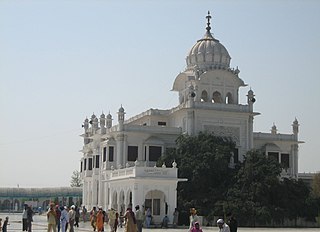
Sultanpur Lodhi is a city and a Municipal Council, just 17 miles Kapurthala city in the Kapurthala district in the Indian state of Punjab. The town is named after its founder, Bahlol Lodhi, the future Sultan of Delhi who renamed the town in 1443 C.E. during his time as governor of Punjab, and has also been mentioned in the Ain-e-Akbari. Sultanpur Lodhi is located on the south bank of a seasonal rivulet called Kali Bein, which runs 6 miles (9.7 km) north of the confluence of the Beas and Sutlej rivers of Punjab.
The Khangura is a gotra of Jat community from the Punjab region in India.
Narur, also known as Naroor and sometimes Naror, is a large village in Punjab, situated 17 km from Phagwara. The area is 183 hectares with a population of 2485.

Bandi Chhor Divas, also known as Bandi Chhor Dihara, is a Sikh celebration commemorating the day when the sixth Guru of Sikhs, Guru Hargobind, and 52 Hindu kings were released from Gwalior Fort, who had been imprisoned by Mughal Emperor Jahangir. Emperor Jahangir had held 52 Kings at the Gwalior Fort for several months. Gurdwara Data Bandi Chhor Sahib is located at the place of the Guru's internment in the Fort. The day falls in autumn and often overlaps with Hindu Diwali, the festival of lights celebrated across Punjab and the rest of India. Historically, from the time of the third Sikh Guru Amar Das, Sikhs and Hindus of the time used the occasion of Diwali, Vaisakhi and other such festivals to congregate at the seat of the Gurus. In 2003, Sikh religious leaders and the Shiromani Gurdwara Parbandhak Committee led by Prof. Kirpal Singh Badungar formally adopted this day into the Nanakshahi calendar.
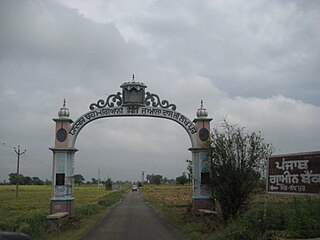
Lakhpur is a village near Sahni (Lakhpur-Sahni), Tehsil Phagwara, Kapurthala district, in Punjab, India.
Chak Prema is a village in Punjab, Tehsil Phagwara, Kapurthala district. The Gate to Lakhpur is located near this village. Neighbouring villages include Lakhpur, Sangatpur, Dhadday, Dhadoli, Bir Dhadoli, Wariah, Gulabgarh and Khatti.
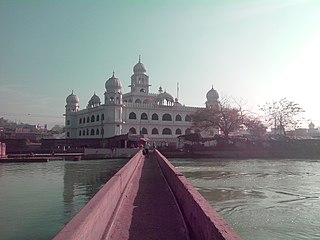
Kiratpur, also known as Kiratpur Sahib, is a town, just 30 km from Rupnagar city in Rupnagar district of Punjab, India. The town is the location of the Gurdwara Patal Puri where many Sikhs take ashes of their deceased.
Domeli is a village in Tehsil Phagwara, Kapurthala district, in Punjab, India.
Babeli is a village in Tehsil Phagwara, Kapurthala district, in Punjab, India.
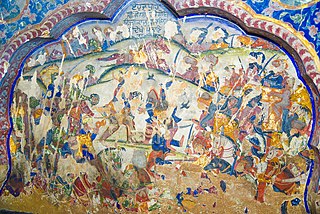
The Battle of Kartarpur occurred on 25 April 1635. It started when the Mughal Empire attacked the town of Kartarpur. The Mughal force was repulsed by the Sikh defenders. The battle occurred in the locality of Kartarpur in present-day Jalandhar district of Indian Punjab.






































